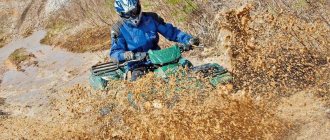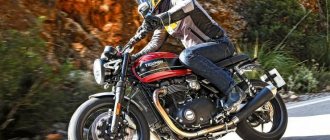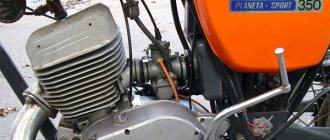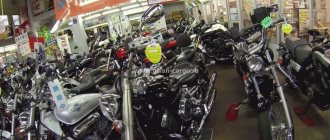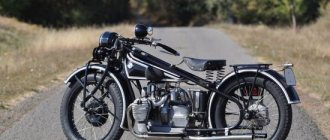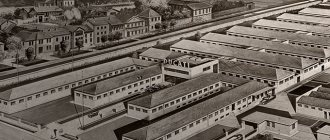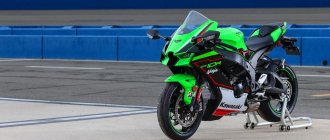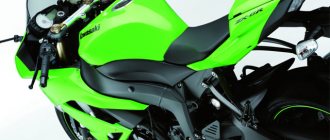Kawasaki KVF 750 Brute Force – a progressive and modern development originally from Japan
JAPANESE DESIGN The ATV's classic steel rigid duplex frame houses a 749cc, 90-degree V-twin engine. cm and power 50 l. With. A few years ago it received new cylinder heads with new camshafts, which increased the compression ratio and improved torque in the lower rev range. Japanese engineers also reconfigured the fuel injection system and updated the firmware of the engine control systems.
Surprisingly, the KVF is equally good both off-road and on high-speed dirt roads.
During the next planned revision, the KVF 750 was equipped with a new larger radiator, and the expansion tank was moved to a niche near the front wheel. The engine is complemented by a transmission with all-wheel drive, a reduction range in the CVT and a locking front cross-axle differential with manual drive. The bright yellow lever for turning it on is located above the brake lever on the left side of the steering wheel. When overcoming serious obstacles, it is enough to press it with your index finger and continue moving. To unlock the differential you just need to release your finger. Another interesting feature of the Brute Force design: the air filter is located in the cleanest possible place - under a special plastic cover near the steering column of the ATV. And air intake for the engine is made directly under the seat, which significantly increases the vehicle’s maneuverability when crossing water obstacles. The steering system is equipped with an adaptive electric power steering EPS, which significantly dampens all irregularities under the wheels of this car. The KVF 750 has independent multi-link suspensions with five-stage adjustment of the spring preload of the front and rear shock absorbers. The front travel is 169 mm, the rear – 190.
The Brute Force's suspensions are of a traditional "scrap" design - independent
There is even a spare power fuse included at the factory.
Thanks to this arrangement of the air filter, there is no need to be afraid of deep fords.
The front cross-axle differential locking lever is located... on the steering wheel!
The car has a well-designed stock underbody protection
The dashboard is boring, but quite informative
A PLEASANT SURPRISE In general, although the Brute Force boasts pleasant and interesting solutions like the locking lever and the location of the air filter, at first glance it still seems like the most banal Japanese ATV. But sea trials showed that this is not entirely true! An updated engine, variator settings and, perhaps, some Japanese magic unknown to me make this all-terrain vehicle quite angry and sharp. Despite the modest 50 horsepower, the KVF 750 drives no worse than its larger cubic brethren in the flagship class. We did not carry out special measurements, but the “Japanese” feels not much inferior to the liter Canadian and Japanese models. The power plant is simply superb. “Kvadrat” reacts very sensitively to manipulations with the gas trigger and, at every opportunity, launches a three-hundred-kilogram car into a controlled side drift. But in every barrel of honey there is sure to be a drop of bitter machine oil. The car's simple and unsightly suspension does not at all correspond to the cocky nature of its power plant. If you drive, as they say, with all your money, then they simply will not have time to work off all the obstacles encountered under the wheels. So to use the Japanese fighter in country and rally racing, its suspension will have to be modified. The second rather significant drawback that I would like to note is the overly intrusive operation of the power steering. At high speeds, there is practically no feedback on the steering wheel and the driver may well make a fatal mistake when piloting. But if you install a competent suspension system on the Brute Force, invigorate the power plant a little more and turn off EPS, then the KVF 750, especially considering its cost, may well become a real competitor to the sports models of Polaris and Can-Am. Also, in fairness, I would like to note that if you have the “correct” mud tires, the stock Kawasaki becomes almost all-climbable.
Thanks to its excellent powertrain, Kawasaki easily competes with larger ATVs
In general, taking into account global currency conflicts and the depreciation of the ruble, this Japanese ATV may turn out to be a very attractive acquisition that will allow its owner to truly enjoy the full range of off-road all-wheel drive leisure. After all, the potential of this car is enough for both tourist adventures and amateur sporting events of almost any level.
ATV provided by dealer
Specifications
The motorcycle engine is structurally almost identical to the liter source from the ZR-7 model.
While developing the engine, the Japanese encountered a problem.
Then production started out of the blue. They took the motor from the flagship and rebuilt it. The result was a smaller flagship that produced:
- working volume - 748 cm3;
- number of cylinders - 4, in-line arrangement;
- number of cycles - 4;
- number of valves - 16, 4 per cylinder;
- power - 109 (106) hp;
- torque - 75 (78) Nm;
- cooling - liquid;
- fuel supply - injector (injector + KDTV);
- ignition - digital;
- start - electric starter;
- tank volume - 19 (18.5) l.
The indicators of the second generation of the motorcycle, which entered the production line in 2007, are given in brackets.
Transmission and clutch
A classic chain drive and six-speed gearbox are more than enough for a naked bike of this level.
The motorcycle was equipped with a 6-speed gearbox.
True, after several trips, further operation did not cause any problems. A significant part in this was played by the fact that the box itself is quite elastic, and the gear ratios are spaced far apart - there is no need to click often.
- The clutch is standard, multi-plate, in an oil bath. Power transmission is a cable.
- The main drive is chain.
Brakes
Front brakes – 2 discs.
Rear brakes – 1 disc.
Front brakes:
- number of disks - 2;
- disc diameter - 300 mm;
- support - 2-piston.
Rear brakes:
- number of disks - 1;
- disc diameter - 250 mm;
- support - 1-piston.
Another advantage of the update was the appearance of ABS on both disks. Some users noted that this is an optional feature, but the manufacturer noted that it is already installed at the factory.
Kawasaki Z750R: 2011 model review
The 2011 version was produced with a four-stroke power unit. Engine with four cylinders arranged in a row and sixteen valves. It produces one hundred and five horsepower. The volume is 748 cubic centimeters, just like the basic version of the Kawasaki Z750. But the potential of the motor is not fully developed. When driving, it seems as if a smaller engine is installed. There are analogs that, with the same volume, produce one and a half times more power (up to one hundred and fifty horsepower).
The manufacturer claims that the Kawasaki Z750R accelerates to two hundred and ten kilometers per hour. But not always a motorcyclist can reach this level. The bike does not have wind protection, which is a significant disadvantage of the model.
From its predecessor, the Kawasaki Z750R took a new fork (41 mm). The rear suspension is represented by a shock absorber. The two-wheel suspension has rebound and pre-stiffness adjustment. The model also features radial calipers and a lightweight pendulum.
The braking and control systems have changed for the better. But the effect is spoiled by the increased weight of the motorcycle, which is 224 kilograms. A regular engine with a medium displacement cannot confidently “pull” such a weight.
At the front there are two wheels (three hundred millimeters), radial calipers and four pistons. The rear wheel braking system is different. For the purpose of stopping, a two hundred and fifty millimeter disc and one piston are installed on the caliper.
The frame is made of steel pipes. The height of the motorcycle at the saddle is eight hundred and twenty millimeters.
Fuel consumption is five liters per hundred kilometers. The motorcycle accelerates to hundreds in twelve seconds.
006_0210_030
The potential of the front brakes is fully consistent with the phlegmatic character of the engine. The potential of the front brakes is fully consistent with the phlegmatic character of the engine.
In contrast to the well-deserved engine, all other components of the Zeerka fully meet all the requirements necessary for the title of “modern city motorcycle”. The Kayaba fork and monoshock absorber, combined with a fairly rigid (in its class) frame and 17-inch cast wheels, do an excellent job not only with road surface defects, but also allow you to maneuver quite briskly in traffic. The motorcycle easily and naturally (again, by the standards of the class) takes turns, without requiring much effort from the pilot and without unnerving him with excessive sensitivity to irregularities, although, of course, to the detriment of control acuity. In principle, it will even allow you to “scratch” your knee sliders on the asphalt of the karting track, but, of course, not for the sake of record seconds, but only for pleasure and practice.
007_0210_030
The calipers front and rear are the same, but the efficiency of the rear brake is clearly not enough.
The calipers front and rear are the same, but the efficiency of the rear brake is clearly not enough. The ZR-7, thanks to its softness and some thoughtfulness, will forgive the pilot those mistakes that even the practically standard Honda CB400 Super Four in this regard will not tolerate - the “best device for beginners” so beloved by everyone, and almost twice the displacement will guarantee that that after half a season or a season you won’t get tired of the motorcycle. What is not an alternative to the “four hundred”? It is precisely for this softness and complaisance (which the author, out of fear and indignation, called dullness and lethargy) that girls love the ZR-7 so much. After all, they often do not need either cosmic acceleration or footpegs cut off on the asphalt, and the power reserve of the “four hundred” is no longer enough, especially on a country road. By the way, for long-distance travellers, the “kvak” is no worse than any other “adult” tourist: the already mentioned softness and energy-intensive suspension and excellent ergonomics make it an excellent “long-distance driver”, you just need to install a windshield and luggage bags. Or you can just look for the ZR-7S modification, already equipped at the factory with a bikini half-fairing.
Model description
It’s hardly possible to describe the Brute Force 750 in a nutshell, but we can safely talk about the progress of the developers.
Many of the initial shortcomings were gradually corrected, and today we have one of the best ATVs for off-road and not only among the Kawasaki ATV lineup.
What did they fix? Initially, the model did not have a very strong frame, which could bend or crack during long journeys with jumps and flights. Which, of course, made no one happy.
However, already in 2012, the company updated the frame, making it from steel tubes, reinforced at the fasteners.
This increased the operating time of the ATV, and also significantly improved its quality.
Anyone familiar with the early Kawasaki 750 models could see a clear analogy between the stamped steel wheels and the AvtoVAZ. They were durable and went everywhere they needed to go.
But they looked catastrophically meager and downright bad. Also in 2012, the developers pleased everyone with 6-spoke light-alloy wheels.
Such tires not only perform all the functions of the previous ones, but also weigh much less. Such an ideal concept loudly declared itself.
The model has disadvantages, although they are few.
To begin with, it’s worth saying that the ATV is very pleasant when riding on a dirt road or even just through the forest, but as soon as you drive out onto average-quality asphalt, that’s all - the steering wheel becomes steel, shaking, extended braking distances and inflexible turns make the ride less than pleasant.
However, there are many warnings on the ATV, such as “never use on public roads.”
Now it’s worth moving on to the most pleasant part of the description – the advantages. Brute Force did an excellent job creating the perfect ATV.
If you love extreme travel with ups and downs, then the Kawasaki 750 is your choice. It is also worth considering that the cross-country ability on grass, mud, stones, logs and other surfaces is beyond praise.
Don't even think that this big guy won't be able to gracefully turn into a power drift. A word about the brakes - if you press both levers in one instant, the Kawasaki Brute Force 750 will stand up abruptly. It just gets up and that's it. The main thing is not to fly out of the saddle.
001_0210_028
Kawasaki ZR-7, neoclassic, 2001, 738 cm3, 76 hp, 170,000 rub.
Kawasaki ZR-7, neoclassic, 2001, 738 cm3, 76 hp, 170,000 rub. When I first saw the ZR-7 - with its fast, light plastic shapes, huge brake discs and a hefty muffler "can" - I was amazed by its beauty and athleticism - like a street fighter! The design of this “quack” cannot be compared with the axe-hewn Honda CB750 or the inconspicuous Yamaha XJR1200. The only detail that stands out somewhat from the overall appearance is the power unit. A hefty “row” of air-oil cooling, richly striped with cooling fins and replete with right angles surrounded by smooth bends of the linings, it looks like an alien from the past (and, by the way, it is, but more on that below). But overall the device is perceived very harmoniously. The appearance of the “zeerka” makes it similar to the more modern generation of neoclassics, such as the Honda Hornet, Yamaha Fazer or Suzuki GSR600. That is why, from the first glance at him, I expected extraordinary agility, sharp control and a hooligan character.
